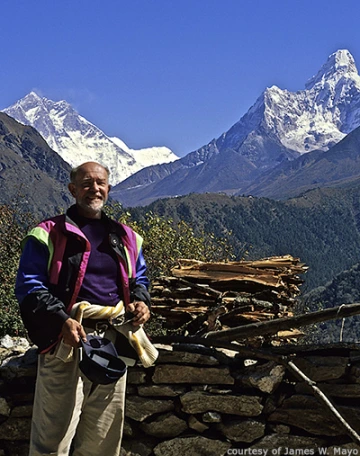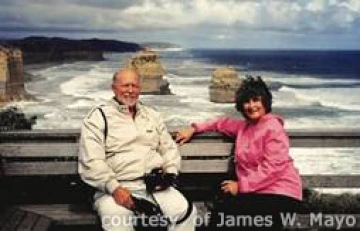Etendue: James W. Mayo III
Welcome to Etendue, featuring interesting and accomplished individuals known for their leadership and contributions both with their careers and the College of Optical Sciences, in their own words. (For a similar view on the college’s best and brightest – our students – please check out Another Wavelength among our Students in the Spotlight.)
This week, we hear from James W. Mayo III, M.S. 1968, who holds the historic role of OSC's first graduate.

Where are you from?
It all started in Memphis, Tennessee, where I was born just as the Great Depression was winding down and World War II was heating up ... a most memorable and historically significant time. We shared an 1885 vintage one-story house with another family. We had indoor plumbing but no hot water. Seven people shared one bathroom and a single bathtub. I was the only child in my family. My grandmother lived with us and helped raise me, especially after the war when my mother went to work to help support the family. My earliest academic interests were math, science, history, optics and astronomy. I was observing the sky and making telescopes and optical instruments from war surplus lenses by age 10 and was on the board of directors of the Memphis Astronomical Society at 16. I was a straight-A student who won national academic awards and numerous scholarships. I chose the University of Tennessee because two of my closest friends were going there and UT had a good football team. I also had intense military interests from Army ROTC and the fact that I had several relatives in World Wars I and II. I was an Army ROTC Distinguished Cadet, and later, an Air Force Distinguished Graduate at Tennessee with a B.S. in engineering physics. My first assignment after graduating in 1963 was to the optics lab at Wright-Patterson Air Force Base in Ohio. It was there that my lifelong interest in optics really exploded.

Who or what influenced your interest in optics?
The WPAFB optics facilities were among the world’s finest and offered outstanding opportunities for research in optics for reconnaissance, surveillance and for that new field they called “lasers.” I met Bob Shannon there in 1964 and funded his early laser metrology projects at Itek Corp. in Lexington, Massachusetts. Other projects included pioneering efforts with Perkin-Elmer in Norwalk, Connecticut; J.W. Fecker in Pittsburgh, Pennsylvania; and Eastman Kodak and Bausch & Lomb in Rochester, New York. Those 1960s days were incredible and I had the honor to meet and work with many of the legends of optics from that great era. I served on the Air Force Advanced Optics Education Initiative team and took physics courses at the Ohio State University and optics courses at the University of Rochester. It was during this time period that I first worked with Dr. Aden Meinel on the Air Force role in setting up the Optical Sciences Center at the University of Arizona. This is covered in more detail in my article “The First Graduate Tells All,” published by the College of Optical Sciences in 2008.
Others who influenced my career in optics in the 1960s included the incredible Dr. Jim Baker, Mr. Amrom Katz of Rand Corp., Dr. Rudy Kingslake, Dr. Bob Hopkins, Dr. Phil Baumeister and Dr. Lewis Hyde of the University of Rochester; Dr. Roland Shack, Dr. Nick Stavroudis, Dr. Phil Slater and Dr. Jim Eyer at OSC; Dr. George Economou of Fecker Corp.; Dr. Rod Scott of Perkin-Elmer; and many others. I was introduced to a bright new U of R grad named Jim Wyant at Itek around 1969 and became the first government sponsor and funding agent for his interferometer work. In 1974, Jim joined the Optical Sciences Center and the rest is history.
Describe your career.
I started out delivering circulars, newspapers and cutting yards at the age of 12. By 15, I was playing country-western guitar and that new-fangled “rock and roll.” By 1963, I had given well over 500 performances in 15 states and made several recordings in Memphis, Nashville, Knoxville and Atlanta. My full-time military career began in 1963 with the U.S. Air Force optics lab assignment. In 1967, I attended the Optical Sciences Center on an Air Force Institute of Technology scholarship and became the center’s first graduate in August 1968. This was followed by five exciting years at the Secretary of the Air Force Special Projects Office in Los Angeles, where I worked for Colonel Don Hillman and General Lew Allen Jr., both close friends of Dr. Aden Meinel. Then it was on to command the U.S. Air Force Cloudcroft Observatory in New Mexico, followed by Air Command and Staff College, National Security Management College and three years as infrared/optics projects manager with the Defense Nuclear Agency in Washington, D.C. In 1979, the Air Force Weapons Laboratory in Albuquerque, New Mexico, called and I retired from the military there in 1985 as chief of the Optics and Beam Control Division. In 1985, Logicon RDA made me an offer I couldn’t refuse, and I became the director of the Opto-mechanical Engineering Department at RDA’s Albuquerque office. Northrop Grumman acquired Logicon RDA in 1997. There I worked ground-based, space-based and airborne laser programs and served as Northrop Grumman chief scientist for the Airborne Laser Project.
Describe your current job.
2010 was a pivotal year since I had never planned on working past 70. However, the opportunity to join a newly formed small company in the Albuquerque area was hard to resist. I accepted the appointment as chief optics engineer for Tau Technologies LLC, a technology support company formed by several of my co-workers from the Northrop Grumman office. The appointment was taken with the understanding that I would only work half-time, which I continue to do today. Tau Tech is a small but dynamic company that supports science and engineering research in lasers, optics, imaging, and software simulation products and services. The job is always interesting, sometimes challenging, but rarely overwhelming. I specialize in new optics and telescope projects, laser and astronomy efforts, advanced surveillance concepts and imaging system development. One especially nice aspect of the job is that I don’t have to travel the 100,000 miles per year I did for the previous 40 years in my other positions.
Share your single best OSC experience.
It is a real challenge to come up with a “single best OSC experience” since my OSC involvement goes back over half a century. I’ll always fondly remember the 1960s at OSC and the incredible academic freedom of that time. The OSC professors and staff were truly wonderful and we had great fun while working hard. The hiking and light mountaineering that we frequently did on weekends and school breaks was always a blast. My personal conversations with Dr. Aden Meinel when OSC was being set up and approved for Air Force students in the mid-1960s was especially memorable. I also deeply enjoyed the experience of giving the OSC 40th anniversary keynote address in 2004 at Jim Wyant’s request. Setting up the endowed James Mayo Family Graduate Student Scholarship in Optical Sciences this year with Jim’s most generous assistance was a dream of a lifetime that is, perhaps, at the top of the “best experiences” list.
Why is staying involved with OSC important to you? How are you involved?
I have been involved with OSC since it was founded. I was at the dedication of the first OSC building in 1969 and involved in the very early Air Force funding of optics programs there in the Aden Meinel era. I worked on numerous OSC projects during the 1970s and 1980s, many involving formal evaluation of OSC government-funded research programs with AFRL Chief Scientist Dr. Art Guenther. Equally fulfilling were many years of technical consultation with projects at the Steward Observatory Mirror Lab, Steward Observatory, Multiple Mirror Telescope, Kitt Peak, NOAO, and other Arizona optics and astronomy facilities. I was also an invited speaker for the Meinel conference at the Meinel Building groundbreaking in 2002 and at the unveiling of the Christopher Reis statue in the building lobby. Of course working with Kaye Rowan and others to set up the First Graduate’s Endowed Scholarship in 2014-2015 was yet another recent involvement. I hope such involvement will continue well into the future.
Name one neat fact about you.
Most of the people who know me are aware that my wife Linda and I are both musicians and also avid world travelers. In fact, we just returned from a 27,000 mile around-the-world trip in April. One thing that many may not know is that I suffered from a serious speech defect until my senior year in high school. My home room teacher Mrs. Castleman convinced our school’s speech teacher, Mrs. Cooley, to give me speech therapy every day after class. Mrs. Cooley agreed under the condition that I formally enroll in her speech class and join the school’s debate team. I complied with those conditions and haven’t stopped talking since then. There is nothing I love talking about more than the College of Optical Sciences and what it has meant to my life and the lives and fortunes of thousands of others over the past half-century.
Photos from top: Jim Mayo on the Everest Trail, Solo Khumbu, Nepal, in 1995; Jim and Linda Mayo on the Great Ocean Road, New South Wales, Australia, in 2001.

